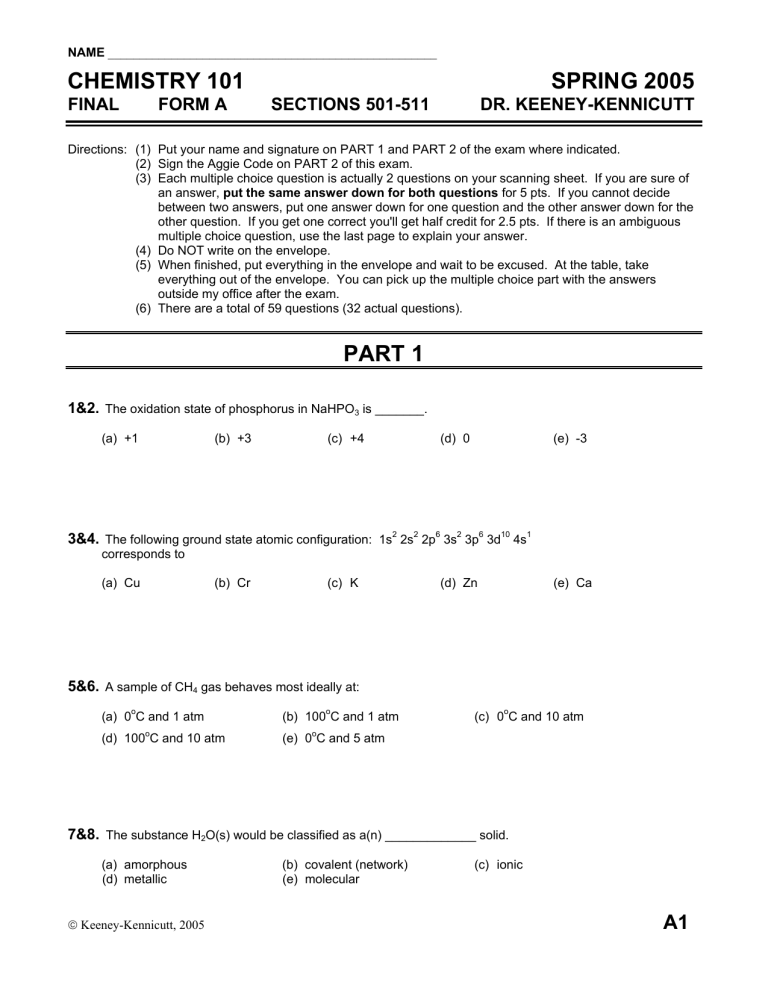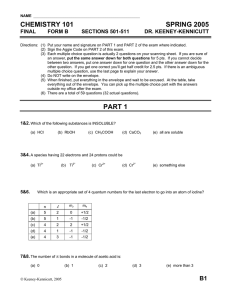CHEMISTRY 101 SPRING 2005 FINAL FORM A

NAME ____________________________________________________
CHEMISTRY 101
FINAL FORM A SECTIONS 501-511
SPRING 2005
DR. KEENEY-KENNICUTT
Directions: (1) Put your name and signature on PART 1 and PART 2 of the exam where indicated.
(2) Sign the Aggie Code on PART 2 of this exam.
(3) Each multiple choice question is actually 2 questions on your scanning sheet. If you are sure of an answer, put the same answer down for both questions for 5 pts. If you cannot decide between two answers, put one answer down for one question and the other answer down for the other question. If you get one correct you'll get half credit for 2.5 pts. If there is an ambiguous multiple choice question, use the last page to explain your answer.
(4) Do NOT write on the envelope.
(5) When finished, put everything in the envelope and wait to be excused. At the table, take everything out of the envelope. You can pick up the multiple choice part with the answers outside my office after the exam.
(6) There are a total of 59 questions (32 actual questions).
PART 1
1&2.
The oxidation state of phosphorus in NaHPO
3
is _______.
(a) +1 (b) +3 (c) +4 (d) 0
3&4.
The following ground state atomic configuration: 1s
2
2s
2
2p
6
3s
2
3p
6
3d
10
4s
1
(e) -3
(a) Cu (b) Cr (c) K
5&6.
A sample of CH
4
gas behaves most ideally at:
0 o
C and 1 atm (b) 100 o
C and 1 atm
(d) C and 10 atm (e) 0 o
C and 5 atm
(d) Zn (e) Ca
(c) 0 o
C and 10 atm
7&8. The substance H
2
O(s) would be classified as a(n) _____________ solid.
(a) amorphous (b) covalent (network)
(e)
(c) ionic
©
Keeney-Kennicutt, 2005
A1
9&10.
An appropriate set of 4 quantum numbers for the "last" electron to go into an atom of platinum
(Pt, atomic number 78) could be: n l m l m s
(a) 5 3 -3 +1/2
(b) 4 3 0 -1/2
(c) 5 2 2 +1/2
(d) 4 2 -2 -1/2
(e) 5 1 0 -1/2
11&12. Which of the following statements is FALSE concerning the compound Fe(NO
3
)
3
?
(a) Each formula unit of Fe(NO
3
)
3
contains 9 atoms of oxygen.
(b) Each mole of Fe(NO
3
)
3
contains 55.85 g of iron.
(c) Each formula unit of Fe(NO
3
)
3
contains 3 nitrate ions.
(d) Each mole of Fe(NO
3
)
3
contains 4 moles of ions.
(e) Each mole of Fe(NO
3
)
3
contains 6.02 x 10
23
atoms of nitrogen.
13&14.
A hypothetical molecule, AB
3
, has two (2) lone pairs of electrons on the center atom, A. The hybridization of A is _______ .
(a) sp (b) sp
2 sp
3 sp
3
(d) sp
3 d
2 d (e)
15&16.
Which of the following substances is INSOLUBLE?
HNO
3
2
(e) all are soluble
17&18.
The correct dot structure for SF
4
contains ______ lone pair(s) of electrons around the central atom.
©
Keeney-Kennicutt, 2005
A2
19&20.
Valence Bond Theory uses the concept of resonance to explain the structure of _______.
(a) SO
4
2
-
(b)
3
2
-
(c)
3
-
21&22.
According to Bronsted-Lowry Theory, which acid is INCORRECTLY matched with its conjugate base?
ACID CONJUGATE
(a) HCl Cl
-
H
2
F
+
HF
H
3
O
+
3
-
CO
OH
3
-
2
-
(e) PO
4
-
HPO
4
2
-
23&24. The number of
π
bonds in a molecule of benzene is:
25&26.
Which of the following species is INCORRECTLY paired with its molecular or ionic geometry?
(a) linear
(b) linear
(c) planar
2
-
pyramidal
(e) bipyramidal
27&28.
Which statement is WRONG?
(a) A carbon atom is smaller than a silicon atom.
(b) The most stable calcium ion is Ca
2+
.
(c) A magnesium cation is smaller than a magnesium atom.
(d) The atomic weight of oxygen is about 16.
(e) Oxygen has a less negative electron affinity than nitrogen.
©
Keeney-Kennicutt, 2005
A3
29&30.
The correct ranking of substances according to their boiling points from lowest boiling point to highest boiling point is:
(a) He < CH
4
< NH
3
< NaCl
(b) He < NH
3
< CH
4
< NaCl
(c) He < CH
4
< NaCl < NH
3
(d) < He < NH
3
< NaCl
(e) NaCl < He < CH
4
< NH
3
31&32.
A species having 28 electrons and 30 protons could be:
Ni
2+
(a) Zn
2+
(b)
2
-
2
-
33&34. Which of the following species is polar?
BeF
2
-
(c)
+
(d)
35&36. What is the percent of oxygen by mass in vanillin, C
8
H
8
O
3
?
(a) 31.5% (b) 19.2% (c) 15.8%
(d) 25.8% (e) 10.5%
©
Keeney-Kennicutt, 2005
A4
37&38. Consider the reaction: H
2
(g) + O
2
(g)
→
H
2
O(g) UNBALANCED
The initial system before the reaction began is represented by the following particle view: where is a hydrogen atom
is an oxygen atom
is a water molecule
Give the limiting reactant and the number of molecules of H
2
O that can be produced.
(b) H
2
, 2 (c) O
2
, 1 (d) O
2
, 2 (e) another answer
39&40. How many grams of Na
2
O
2
(FW - 78.0 g/mol) can be produced from the reaction of 10.0 g of sodium metal with excess oxygen gas if the percent yield of the reaction is only 55%?
2 Na + O
2
→
Na
2
O
2
(a) 5.8 g (b) 12.2 g (c) 8.6 g (d) 6.8 g (e) 9.3 g
©
Keeney-Kennicutt, 2005
A5
41&42.
Air bags for automobiles are inflated during a collision by the explosion of sodium azide, NaN
3
(FW =
65.0 g/mol). The equation for the decomposition is:
2NaN
3
(s)
→
2Na(s) + 3N
2
(g)
What mass of sodium azide is needed to inflate a 25.0 L bag to a pressure of 1.40 atm at 20 o
C?
(a) 14.4 g (b) 88.1 g (c) 93.1 g (d) 63.1 g (e) 155 g
43&44.
What volume (in mL) of 0.45 M NaBr can be prepared from 25 g of NaBr (FW = 103 g/mol)?
(a) 320 mL (b) 480 mL (c) 610 mL (d) 540 mL (e) 270 mL
©
Keeney-Kennicutt, 2005
A6
45&46. You are given the data for all the isotopes of the newly discovered element, Aggiedaddium:
Abundance (%)
10.00
50.00
40.00
Isotopic Mass (amu)
122.00
125.00
128.00
The atomic weight of Aggiedaddium (in amu) is (to 4 significant figures):
47&48.
A student must prepare a 0.100 N solution of KMnO
4
which will be used in this UNBALANCED net ionic reaction occurring in acidic solution:
MnO
4
-
+ Fe
2+ →
Mn
2+
+ Fe
3+
How many grams of KMnO
4
must be used to make 1000 mL of this 0.100 N solution?
(a) 3.16 g (b) 7.04 g (c) 10.2 g (d) 15.1 g (e) 19.8 g
©
Keeney-Kennicutt, 2005
A7
49&50.
What could be the identity of a gas if its density is 3.74 g/L at STP? l
2
(b) SO
2
(e)
51&52.
This is the question being replaced by your doing the evaluation of the course on the web.
©
Keeney-Kennicutt, 2005
A8
PERMISSION
I, (print your name) _____________________________________________________ give permission to
Dr. Wendy Keeney-Kennicutt to anonymously use any of my work done in her Chemistry 101 class during Spring
2005 as examples to illustrate to others how she teaches in her class. This includes homework, abstracts, CPR assignments, free response part of exams, labs, etc.
Signed: _______________________________________________________________________
Date: ______________________________________
©
Keeney-Kennicutt, 2005
A9
©
Keeney-Kennicutt, 2005
A10
CHEMISTRY 101
FINAL
Form A
SPRING 2005
S 501-511
NAME
Signature
PART 2
Please read and sign: “On my honor, as an Aggie, I have neither given nor received unauthorized aid on this exam.” _______________________________________________
(7 pts) 53. Write a balanced net ionic equation to represent the oxidation of iodide ion (I ion (MnO
4
-
-
) by permanganate
) in basic solution to yield molecular iodine (I
2
) and manganese(IV) dioxide (MnO
2
). Use smallest whole number coefficients.
OVER
⇒
©
Keeney-Kennicutt, 2005
A11
(5 pts) 54. Here is a molecular representation of a reaction occurring in the gas phase at 300 K and 1 atm pressure. If the initial volume is 1.00 L, determine the final volume if the temperature and pressure don't change and explain briefly how you arrived at your answer.
(6 pts) 55.
Draw a typical phase diagram. Label the axes and the areas where solids, liquids and gases can be found. Draw a line segment representing the phase change of a solid to a gas at constant pressure.
©
Keeney-Kennicutt, 2005
A12
(6 pts) 56.
Determine the complete net ionic equation for the reaction between nitric acid and copper(II) hydroxide.
(6 pts) 57.
Given the following data:
Specific Heat of ice: 2.09 J/g o
C
Heat of fusion of ice at 0 o
Specific Heat of liquid H
2
Specific Heat of steam
J/g o
O 4.18
Heat of vaporization of liquid water at 100 o
C 2.26 x 10
C
3
J/g
2.03 J/g o
C
Calculate the amount of heat (in kJ) required to convert 20.0 g of ice at -40 o
C to liquid water at
50.0
o
C.
©
Keeney-Kennicutt, 2005
A13
(6 pts) 58.
What is the initial boiling point of a solution prepared by dissolving 35.0 g of sodium phosphate in
100.0 g of water? The boiling point of water is 100.00
o
C and K b
for water is 0.512 o
C/m).
(4 pts) 59.
Draw a picture of the p x
orbital and label the axis.
©
Keeney-Kennicutt, 2005
A14
SCRAP PAPER OR COMMENTS ON EXAM
CHEMISTRY 101
FINAL Form A
Spring 2005
S 501-511
NAME
©
Keeney-Kennicutt, 2005
A15




